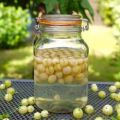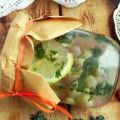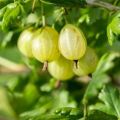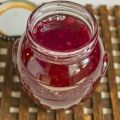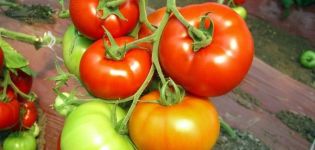Simple and original recipes for making red and black currant compote with gooseberries for the winter
Each housewife tries to stock up on vitamins for the winter, to keep vegetables and fruits as intact as possible. For this, there are recipes for jams, pickles, marinades, accumulated by many generations, summarized in collections of tips and books on cooking. And how to make a delicious compote of red currants and ripe gooseberries for the winter will certainly be interesting to many - for this you need to read this article to the end.
Features of cooking gooseberry and currant compote
Cooking is almost an art: one extra ingredient, and the taste changes exactly the opposite. Although it is believed that this is how real masterpieces are created. With regard to the situation with the gooseberry and currant compote, it is necessary to take into account the fact that both products contain a large amount of ascorbic acid, it is also vitamin C. This means that it will be necessary to "balance" excessive acidity with sugar, but at the same time not to exceed the norm so as not to bring the product to sugary. It is also impossible to boil the mixture for a long time: the high temperature destroys most vitamins and trace elements, turning the useful compote into tinted sweet water.
Therefore, a drink made from gooseberry and currant berries is prepared according to a special recipe, but the secret of a real fortified cocktail will be revealed a little later.
What varieties of currants to choose
In order for the compote to turn out to be truly tasty, rich, and most importantly, to retain its useful qualities for a long time, it is necessary to choose ripe berries, follow certain rules - otherwise the final product may turn out to be too sour or, conversely, overly cloying, the pleasure from it will be hopelessly spoiled.
Breeders have developed a great variety of currant varieties, they are different in fruit size and taste, but the main ones are reduced to 3 types:
- black;
- red;
- white.

Appetizing, rich in nutrients, including vitamins C, A, groups B, P, E, sugar, essential oils, pectins, organic acids and trace elements, berries are useful in all varieties. Most of all in currant ascorbic acid and retinol (vitamins A and C), and white is superior to black in the content of folic acid and carotene.
And the fruits are rich in antioxidants, are low-calorie foods (42 calories per 100 grams). Therefore, it is difficult to specifically recommend the choice of one or another type.Better to rely on your personal preferences.
Important. Currant berries, regardless of the variety and size, are very tasty, juicy, and also healthy: they contain vitamins A, C, B, organic acids, antioxidants and trace elements - a real natural pantry! It is imperative to prepare compote from them.

Choosing gooseberry varieties before starting the process
Gooseberry is a unique plant with characteristic striped fruits, but its value is not only in form, but also in content. The following varieties are known from those growing in Russia: English, emerald, Russian, change, honey, Moscow, spring, dessert and many others.
Berries contain provitamins A, vitamins B and C, as well as polysaccharides, minerals, pectins, trace elements. Darker varieties are rich in vitamin P, which helps neutralize heavy metal compounds.

In general, the choice of this or that species is not so important as the classification according to the degree of ripeness. The fact is that slightly unripe fruits are suitable for compote, it is desirable that they be about the same size. Overripe berries are good for jellies and preserves, but completely green ones will not allow you to reveal the full rich potential of gooseberries.
Important. There is an opinion that in the gooseberry compote, which has a peculiar taste and rich fresh aroma, the presence of currants enhances these qualities and color, since without it the infusion is very light, transparent.
Preparation of the main ingredients
Before preparing a tasty and healthy compote, you need to do a few simple, simple steps. They will preserve the properties of the berries, and also make the drink pleasant for aesthetic perception. Yes, yes, because nutritionists believe that food should be not only nutritious, but also beautiful, which is why so much attention is paid to serving in restaurants and self-respecting catering places.
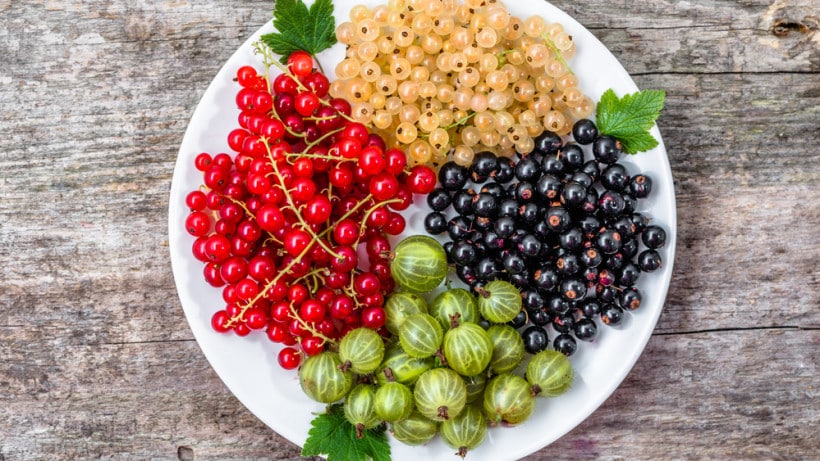
So, a step-by-step algorithm for processing berries:
- The collected gooseberries and currants are sorted out, washed, tails are removed, ripe and green fruits are sorted. The gooseberry is slightly pricked, since it has a dense skin (so that the syrup gets inside and the berries are well boiled).
- Prepare the dishes. If the compote is supposed to be consumed immediately, then a saucepan will be enough, if for storage, then glass jars of the required amount and volume will also be needed.
- You will definitely need granulated sugar, exactly how much - it will become clear based on the consumption of berries.
- The last component is covers (needed if we are talking about blanks for the winter).
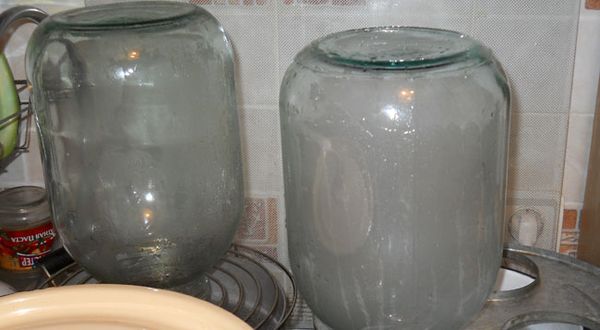
These are all the main ingredients and ingredients that a hostess may need before cooking compote.
How to make gooseberry and currant compote at home
There are several recipes for making a delicious, aromatic compote, which is good for cooling in the summer heat, eating it for breakfast or as an aperitif, as well as for the future (for a long, cold winter, when the body especially needs a vitamin supplement). They differ in the proportions of the components and some additional additives that improve the taste, but, in general, they do not present any particular difficulties in preparation.
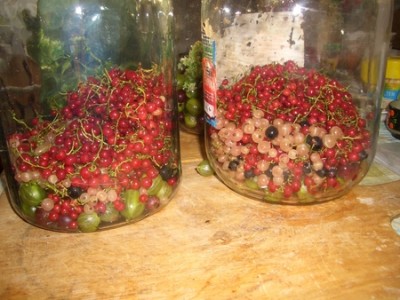
A simple recipe for the winter
To implement a simple way to pamper yourself with delicious, you will need: harvested berries, a saucepan of suitable sizes and granulated sugar. The fruits are washed, the tails are removed (on both sides of the gooseberry, the dried leaves are removed from the currant), and prepared for cooking. In total, you will need 1 glass of each type (this is about 250 grams), you can experiment with currants: mix red and black or black and white in equal parts, the taste will only benefit from this.
Cold water (3 liters) is poured into cleanly washed dishes, sugar (200 grams) is added to it, mixed, brought to a boil, so that a syrup is obtained.It is very important to understand that the end goal is not to boil the berry, but to lightly treat it with a hot solution.
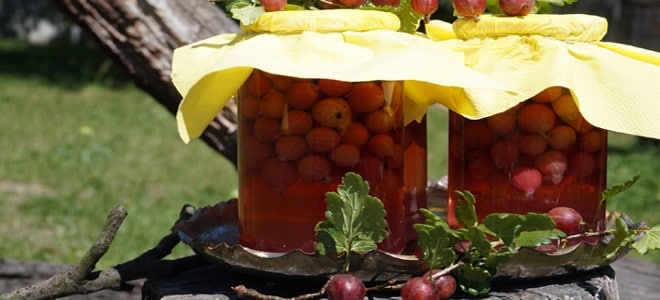
Therefore, the mixture of fruits in syrup is brought to a boil, then kept on low heat for no more than 2 minutes, removed from the stove and allowed to brew. Gooseberry compote over time acquires a rich taste and aroma, it is for this that the last condition was invented. Next, the finished drink is cooled, poured into a jug and consumed - with cookies, buns, gingerbread or just like a tonic.
Without sterilization
This recipe is fraught with some trick: you still have to sterilize, but not ready-made compote, but only jars with lids. You will need to make a calculation to determine the consumption of components and the amount of glass containers. Berries, water and sugar will be needed in approximately the following proportion:
- 200 grams of gooseberries;
- 300 grams of currants;
- 300 grams of sugar;
- 2.5 liters of water.

This is a calculation for one 3 liter can. For smaller or larger volumes, it is adjusted. You can take red currants, in this case they leave twigs. Further, simultaneously with the sterilization of the container, the syrup is prepared: it is brought to a boil and "boiled" for 2-3 minutes. Then a hot solution is poured into a prepared jar, in an amount of about 0.5-1 liters, the fruits are poured there and at the end they are filled with liquid under the neck.
After that, the lid is rolled up, the finished compote is turned upside down (this is how the lids are drawn in better), covered with a blanket and allowed to cool completely for a day.
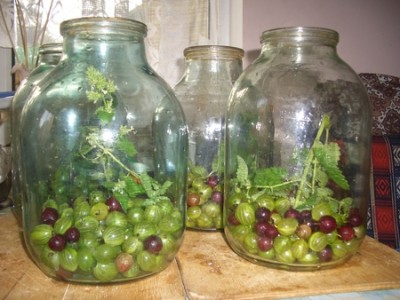
The method is simple, but effective: due to the interaction with hot syrup, the berries blanch, completely preserving all the healing substances, and the absence of air in the jar does not allow fermentation processes to develop.
With raspberries
Another original recipe that has every right to exist. To implement it, you will need (the quantity is indicated in the glasses):
- ripe but strong gooseberries (2 tbsp.);
- raspberries (3 tbsp.);
- granulated sugar (2 tbsp.);
- clean water (10 tbsp.).
Important. Variations in the amount of sugar for a sweet tooth are allowed, but not less than the specified norm.
The berry gets over, garbage, stalks, and unusable fruits are separated from it. It is recommended to wash the gooseberries and raspberries in a colander, leaving them to drain at the end of the procedure. Next, the standard processing of cans is carried out: washing, sterilization in boiling water. At the same time, the syrup is being prepared, the process consists in pouring sugar into hot water with thorough mixing until it is completely dissolved. You can cook it a little, but not for long (no more than 3 minutes).
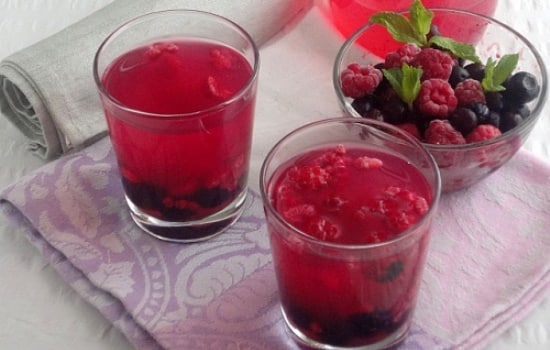
Fruits are poured into the prepared container (in equal proportions), which are then poured with hot sugar solution. The last stage remains - sterilization of the compote itself: a towel is placed in a pan with a wide bottom (to avoid direct contact of the bottom of the cans with the metal), and then the cans covered with lids are installed. The water level should reach approximately to the hangers, it takes 40 minutes to boil the container, which is mandatory over the lowest heat. Then the cans are carefully removed, rolled up with lids, turned upside down and left in this position for about a day. Delicious homemade compote is ready for the winter.
With cherry
This recipe is a real assortment of taste and color: dark cherries contrast well with lighter gooseberries, and the taste sensations of this compote are difficult to convey in words. You will need:
- cherry;
- gooseberry;
- sugar;
- lemon acid.
Cooking begins with sorting out the berries: tails, stalks, leaves are removed from the gooseberry, and the seeds are removed from the cherry. The fruits are washed in a sieve or colander under running water. A 3 liter glass jar is washed with soda or dish detergent, rinsed, sterilized over a boiling kettle (steam). The tin lid for preservation is prepared separately, it is boiled for 5 minutes.

Compote is prepared in 2 stages: first, the berry is poured into the jar, filled with water preheated to a boil and left to cool. Then the water is poured into a saucepan, sugar is added there, the mixture is boiled with stirring until a homogeneous composition is obtained. The hot syrup is re-poured into the jar, a pinch of citric acid is poured into the same (at the tip of a knife), after which the lid is rolled up. Then the container is turned over, wrapped and left in this form for several hours.
The consumption of components per 3 liters is:
- 200 grams of gooseberries and cherries;
- 250 grams of granulated sugar;
- a pinch of lemon.
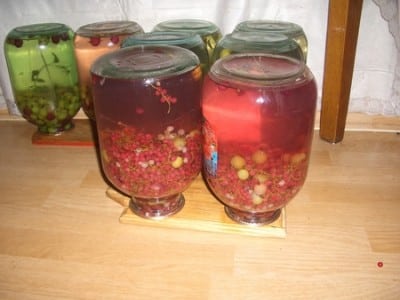
How long is compote stored
It is advisable to consume the finished drink made from fresh berries as soon as possible: this way there will be more benefits from it and the tasting will not end with food poisoning. Compotes rolled up in jars are a completely different matter: they can be safely stored for a whole year, until the new harvest, it is not even necessary to put them in the refrigerator. But if seeds remain in the berries, then the shelf life is reduced: in such fruits, hydrocyanic acid accumulates over time - a strong poison that is dangerous to humans.
Rules for storing gooseberry and currant drink
The sterilized preservation is stored in a dark place, protected from direct sunlight - a closet, basement or cellar. You can also use a refrigerator for these purposes, but not necessarily: without air access, the products inside the jar will not oxidize, they do not need extra cold.
And a tasty, healthy drink made from juicy berries, carefully prepared with your own hands, will definitely come in handy in the summer heat and cold winter - you will find a real supply of vitamins and microelements in it.


